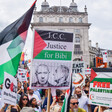Rights and Accountability 10 August 2018

The colleagues of Abdallah al-Qatati mourn outside a Khan Younis hospital after the volunteer medic was shot and killed by an Israeli sniper while on duty during Great March of Return protests on 10 August.
APA imagesTwo Palestinians lost their lives on Friday as Israel used lethal force against Great March of Return protests along Gaza’s eastern perimeter.
One of those killed, Abdallah al-Qatati, 22, was a volunteer medic on duty at the time of his fatal injury in eastern Rafah, southern Gaza.
A photo of al-Qatati circulated on social media after his death: Al-Qatati is the third Palestinian medic to be killed by Israeli forces during Great March of Return protests beginning in late March.The Israeli rights group B’Tselem found that medic Razan al-Najjar, killed on 1 June, was deliberately targeted by an Israeli sniper east of Khan Younis, also in southern Gaza.
Al-Najjar’s death came two weeks after the killing of Mousa Jaber Abu Hassanein, who like al-Najjar and al-Qatati, was wearing clothing identifying him as a medic when he was shot.
The second Palestinian killed on Friday was identified by Gaza’s health ministry as Ali Said al-Aloul, 55, also shot in eastern Rafah.A photo of al-Aloul circulated on social media after his death:
Gaza’s health ministry stated that more than 300 others were injured during Friday’s protests, some 130 treated at hospital.Eighty-five Palestinians were injured by live fire, five of them seriously.
Twenty-six children were among the injured, as well as two journalists and five medics.
This video is said to show a medic being carried away on a stretcher after being shot east of Khan Younis:
This photo shows journalist Mahmoud al-Jamal after he was shot in eastern Rafah: Journalist Alaa Abd al-Fattah al-Namla was shot in the leg, also during protests in eastern Rafah: More than 120 Palestinians have been killed during Great March of Return protests, including 21 children, according to the Gaza-based human rights group Al Mezan.
Palestinians gather at the militarized fence along the Gaza-Israel boundary during protests east of Bureij, central Gaza Strip, on 10 August.
APA imagesIsraeli forces and armed civilians have killed more than 200 Palestinians in the occupied West Bank and Gaza Strip so far this year. Eight Israelis were killed during the same period, including a soldier shot by a sniper in Gaza last month.
Some 5,000 Palestinians have been injured by live fire during the protests.
As of early July, some 60 injuries required limb amputations. Eleven amputees were children. At least 10 more Palestinians were paralyzed as a result of spinal cord injuries.
At the end of June, more than 1,400 Palestinians faced long-term physical disability due to their injuries.
“Gaza’s health sector is struggling to cope with the mass influx of casualties, due to years of blockade, internal divide and a chronic energy crisis, which have left essential services in Gaza barely able to function,” the UN Office for the Coordination of Humanitarian Affairs stated on Friday.
Earlier in the week UN humanitarian coordinator Jamie McGoldrick warned that hospitals would soon be forced to shut down if Israel didn’t allow the entry of UN-funded emergency fuel into Gaza.
McGoldrick’s office warned that fuel stocks to operate water and sanitation facilities are rapidly running out, and that “1.2 million Palestinians are at imminent risk of possible sewage overflow around the 41 main sewage pumping stations in the Gaza Strip.”
Water infrastructure was among the dozens of sites hit by Israeli bombing across Gaza on Wednesday and Thursday. During that bombing campaign a 9-months-pregnant Palestinian woman and her toddler daughter were killed, as was a Palestinian man in a separate incident.
Israel also destroyed a five-story building housing a prominent cultural center.
Palestinians organized a concert on the rubble of the cultural center on Friday: The slogan for the day’s protests along the eastern perimeter of Gaza was “Friday of Freedom and Life.”




